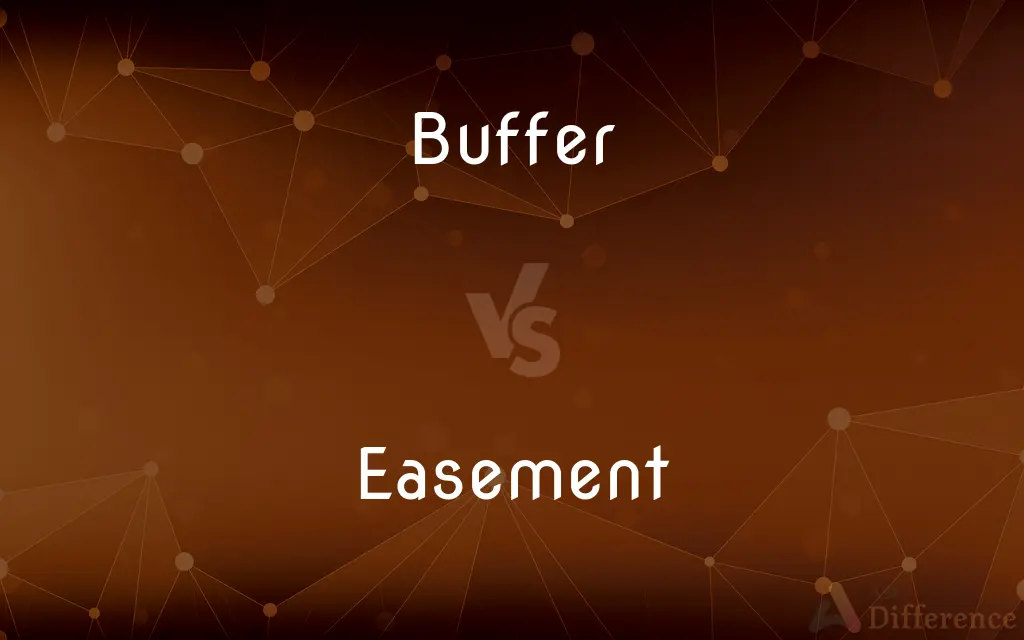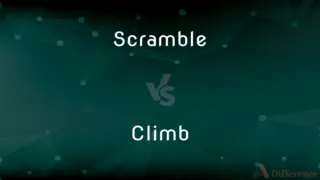Buffer vs. Easement — What's the Difference?
By Urooj Arif & Fiza Rafique — Updated on April 9, 2024
A buffer is a zone separating two areas to reduce impact or interaction, while an easement is a legal right to use someone else's land for a specific purpose.

Difference Between Buffer and Easement
Table of Contents
ADVERTISEMENT
Key Differences
A buffer typically refers to an area of land designed to separate or mitigate the effects of development on certain areas, such as residential communities from commercial zones. This can include landscaping, walls, or natural barriers. An easement, on the other hand, is a legal concept granting the right to use another person's property for a specific purpose, like installing utility lines or accessing a public beach across private land.
Buffers are often implemented as part of urban planning or environmental protection strategies to maintain ecological integrity, manage noise pollution, or preserve visual aesthetics. Easements, however, are established through legal agreements and are recorded as part of the property's title, affecting how the land can be used and accessed by non-owners.
While buffers serve as physical or conceptual separations to minimize interactions between different land uses, easements create pathways of usage rights that can cross property boundaries, enabling activities that might not otherwise be permissible. This distinction highlights the role of buffers in protection and separation, whereas easements focus on access and utility.
The establishment of a buffer zone does not necessarily confer any rights of access to the land within the buffer; it primarily serves as a deterrent or mitigation measure. Conversely, easements explicitly grant certain rights of use or access to others, potentially restricting the landowner's ability to fully control their property.
Buffers and easements both play critical roles in land use and management but address different needs. While buffers aim to protect areas from the impacts of adjacent land uses, easements ensure the legal right to use land for specific purposes, reflecting the balance between private property rights and public or adjacent landowner interests.
ADVERTISEMENT
Comparison Chart
Definition
A zone that separates different areas to reduce interaction or impact.
A legal right to use another’s land for a specific purpose.
Purpose
To protect areas from the effects of development or to maintain natural or aesthetic features.
To grant access or usage rights for utilities, access, or other specific purposes.
Implementation
Through planning regulations, environmental strategies, or development guidelines.
Via legal agreements, often recorded with the property's title.
Impact on Property
May affect land use or development potential but does not grant rights to others.
Grants specific rights to non-owners, potentially limiting the owner's control.
Examples
Landscaping buffers between residential and industrial zones, greenbelts.
Right-of-way for utilities, pedestrian paths, or access to landlocked properties.
Compare with Definitions
Buffer
Often part of urban planning strategies.
Urban planners designate buffer zones to prevent conflicts between commercial and residential land uses.
Easement
May limit the property owner's control over certain areas.
A homeowner cannot build over a utility easement area.
Buffer
Implemented to enhance environmental protection.
Buffers along riverbanks help protect water quality from adjacent agricultural runoff.
Easement
Can be for public or private benefit.
A public beach access path across private land serves the community.
Buffer
Aids in maintaining ecological integrity.
Wildlife buffers around parks reduce the effect of urban encroachment on natural habitats.
Easement
Recorded with the property’s title, affecting future use and sale.
An access easement must be disclosed when selling the property.
Buffer
A zone designed to physically separate or mitigate impacts between different land uses.
A tree-lined buffer between a residential area and a highway reduces noise pollution.
Easement
A legal right to use someone else’s property for a specific purpose.
A utility company holds an easement to install and maintain power lines across private properties.
Buffer
Can be used to preserve visual landscapes.
A landscaped buffer around a shopping center minimizes its visual impact on a neighboring residential area.
Easement
Essential for infrastructure development and access.
Easements allow the extension of sewer lines through private lands to serve new developments.
Buffer
One that buffs, especially a piece of soft leather or cloth used to shine or polish.
Easement
An easement is a nonpossessory right to use and/or enter onto the real property of another without possessing it. It is "best typified in the right of way which one landowner, A, may enjoy over the land of another, B".
Buffer
A buffing wheel.
Easement
The act of easing or the condition of being eased.
Buffer
Something that lessens or absorbs the shock of an impact.
Easement
Something that affords ease or comfort.
Buffer
One that protects by intercepting or moderating adverse pressures or influences
"A sense of humor ... may have served as a buffer against the ... shocks of disappointment" (James Russell Lowell).
Easement
(Law) A right to make limited use of another's land, such as a right of way.
Buffer
Something that separates potentially antagonistic entities, as an area between two rival powers that serves to lessen the danger of conflict.
Easement
(law) An interest in land which grants the legal right to use another person's real property (real estate), generally in order to cross a part of the property or to gain access to something on the property (right of way).
The power company has an easement to put their electricity poles along the edge of this land.
Buffer
(Chemistry) A solution that resists a change in acidity when an acid or base is added to it, or a substance that facilitates this resistance.
Easement
(architecture) An element such as a baseboard, handrail, etc., that is curved instead of abruptly changing direction.
Buffer
(Computers) A device or area used to store data temporarily.
Easement
(archaic) Easing; relief; assistance; support.
Buffer
To act as a buffer for or between.
Easement
The act of relieving oneself: defecating or urinating.
Buffer
(Chemistry) To treat (a solution) with a buffer.
Easement
(model railroading) Transition spiral curve track between a straight or tangent track and a circular curved track of a certain radius or selected radius.
Buffer
(Computers) To hold or collect (data) in a buffer.
Easement
Gratification. en
Buffer
One who polishes with a buff.
Easement
That which gives ease, relief, or assistance; convenience; accommodation.
In need of every kind of relief and easement.
Buffer
A wheel for buffing; a buff.
Easement
A liberty, privilege, or advantage, which one proprietor has in the estate of another proprietor, distinct from the ownership of the soil, as a way, water course, etc. It is a species of what the civil law calls servitude.
Buffer
A good-humored, slow-witted fellow; - usually said of an elderly man.
Easement
A curved member instead of an abrupt change of direction, as in a baseboard, hand rail, etc.
Buffer
A substance or mixture of substances which can absorb or neutralize a certain quantity of acid or base and thus keep the degree of acidity or alkalinity of a solution (as measured by pH) relatively stable. Sometimes the term is used in a medical context to mean antacid.
Easement
(law) the privilege of using something that is not your own (as using another's land as a right of way to your own land)
Buffer
A data storage device or portion of memory used to temporarily store input or output data until the receiving device is ready to process it.
Easement
The act of reducing something unpleasant (as pain or annoyance);
He asked the nurse for relief from the constant pain
Buffer
Any object or person that shields another object or person from harm, shock, or annoyance; as, the President's staff is his buffer from constant interruptions of his work.
Buffer
To add a buffer{5} to (a solution), so as to reduce unwanted fluctuation of acidity.
Buffer
An ionic compound that resists changes in its pH
Buffer
An inclined metal frame at the front of a locomotive to clear the track
Buffer
(computer science) a part of RAM used for temporary storage of data that is waiting to be sent to a device; used to compensate for differences in the rate of flow of data between components of a computer system
Buffer
A power tool used to buff surfaces
Buffer
A cushion-like device that reduces shock due to contact
Buffer
An implement consisting of soft material mounted on a block; used for polishing (as in manicuring)
Buffer
Add a buffer (a solution);
Buffered saline solution for the eyes
Buffer
Protect from impact;
Cushion the blow
Common Curiosities
What is the primary purpose of a buffer zone?
To reduce the impact or interaction between different land uses or to protect environmental features.
How does an easement affect property ownership?
It grants specific rights to others over the property but does not transfer ownership.
How are buffer zones created?
Through urban planning, environmental regulations, or development guidelines.
Does a buffer zone affect property values?
It can, either positively by enhancing environment and aesthetics, or negatively by limiting development potential.
Are easements permanent?
Easements can be permanent or temporary, depending on the agreement.
How can an easement be terminated?
Through expiration, mutual agreement, or fulfilling the purpose for which it was established.
Why are buffers important in urban areas?
They help mitigate pollution, noise, and visual impacts, enhancing livability.
What legal processes are involved in establishing an easement?
Negotiation between parties, drafting a legal agreement, and recording the easement with the property title.
Who maintains a buffer zone?
Maintenance responsibilities can vary, often depending on the buffer's purpose and local regulations.
How is the location of a buffer zone determined?
Based on land use needs, environmental considerations, and planning objectives.
Can a property have both a buffer and an easement?
Yes, a property can have a buffer zone for protection or mitigation and an easement for specific usage rights.
Can a buffer zone be used by the public?
It depends on the type of buffer and local regulations; some are accessible, while others are restricted.
What types of easements are there?
Easements can be for access, utility, conservation, or emergency services, among others.
Can an easement be sold separately from the property?
No, easements are attached to the property and transfer with the sale unless specifically extinguished.
What happens if an easement is violated?
Violations can lead to legal disputes, and the aggrieved party may seek enforcement or damages.
Share Your Discovery

Previous Comparison
Dagoba vs. Pagoda
Next Comparison
Scramble vs. ClimbAuthor Spotlight
Written by
Urooj ArifUrooj is a skilled content writer at Ask Difference, known for her exceptional ability to simplify complex topics into engaging and informative content. With a passion for research and a flair for clear, concise writing, she consistently delivers articles that resonate with our diverse audience.
Co-written by
Fiza RafiqueFiza Rafique is a skilled content writer at AskDifference.com, where she meticulously refines and enhances written pieces. Drawing from her vast editorial expertise, Fiza ensures clarity, accuracy, and precision in every article. Passionate about language, she continually seeks to elevate the quality of content for readers worldwide.
















































